
THE FIRST TRUE HITCHCOCK: “THE LODGER” ■ CREATING A PURELY VISUAL FORM ■ THE GLASS FLOOR ■ HANDCUFFS AND SEX ■ WHY HITCHCOCK APPEARS IN HIS FILMS ■ “DOWNHILL” ■ “EASY VIRTUE” ■ THE RING” AND ONE-ROUND JACK ■ “THE FARMER’S WIFE” ■ THE GRIFFITH INFLUENCE ■ “CHAMPAGNE” ■ THE LAST SILENT MOVIE: “THE MANXMAN”

FRANÇOIS TRUFFAUT. The Lodger, I believe, was your first important film venture.
ALFRED HITCHCOCK. That’s another story. The Lodger was the first true “Hitchcock movie.” I had seen a play called Who Is He?, based on Mrs. Belloc Lowndes’s novel The Lodger. The action was set in a house that took in roomers and the landlady wondered whether her new boarder was Jack the Ripper or not. I treated it very simply, purely from her point of view. Since then there have been two or three remakes, but they are too elaborate.
F.T. In actual fact, the hero was innocent. He was not Jack the Ripper.
A.H. That was the difficulty. Ivor Novello, the leading man, was a matinee idol in England. He was a very big name at the time. These are the problems we face with the star system. Very often the story line is jeopardized because a star cannot be a villain.
F.T. I gather that you would have preferred the hero to turn out to be Jack the Ripper?
A.H. Not necessarily. But in a story of this kind I might have liked him to go off in the night, so that we would never really know for sure. But with the hero played by a big star, one can’t do that. You have to clearly spell it out in big letters: “He is innocent.”
F.T. You know, I am rather surprised that you would consider an ending that failed to provide the public with the answer to its question.
A.H. In this case, if your suspense revolves around the question: “Is he or is he not Jack the Ripper?” and you reply, “Yes, he is Jack the Ripper,” you’ve merely confirmed a suspicion. To me, this is not dramatic. But here, we went in the other direction and showed that he wasn’t Jack the Ripper at all.
I ran into the same problem sixteen years later when I made Suspicion with Cary Grant. Cary Grant could not be a murderer.
F.T. Would he have refused?
A.H. No, not necessarily. But the producers would surely have refused. The Lodger is the first picture possibly influenced by my period in Germany. The whole approach to this film was instinctive with me. It was the first time I exercised my style. In truth, you might almost say that The Lodger was my first picture.
F.T. A very good movie which showed great visual inventiveness. I really enjoyed it.
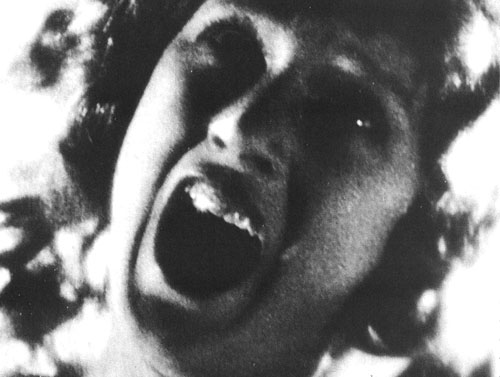
A.H. As a matter of fact, I took a pure narrative and, for the first time, presented ideas in purely visual terms. We took fifteen minutes of a winter afternoon in London, starting about five-twenty. We opened with the head of a blond girl who is screaming. I remember the way I photographed it. I took a sheet of glass, placed the girl’s head on the glass and spread her hair around until it filled the frame. Then we lit the glass from behind so that one would be struck by her light hair. Then we cut to show an electric sign advertising a musical play, Tonight, Golden Curls, with the reflection flickering in the water. The girl has drowned. She’s hauled out of the water and pulled ashore. The consternation of the bystanders suggests that a murder has been committed. The police arrive on the scene, and then the press. The camera follows one of the newsmen as he moves toward a telephone. He isn’t a local reporter, but a wire-service man who is calling his office. And now I proceed to show everything that happens as the news spreads around.
First, the item is typed out on the wire-service machine so that we are able to read a few sentences. Then it is forwarded on the teletypes. People in clubs learn the news. Then there is a radio announcement, with people tuned in to the broadcast. Finally, it is flashed on an electric news sign—you know, like on Times Square. And each time, we give additional information, so that you learn more about the crime. The man murders only women. Always blondes. He invariably strikes on a Tuesday. How many has he killed to date. Speculation on his motives. He goes around dressed in a black cloak and carries a black bag. What is in that bag?
Through all the different means of communication, the information begins to spread, and finally, the evening papers are out on the street. Now we show the effect on various people. Fair-haired girls are terrified. The brunettes are laughing. Reactions in the beauty parlors or of people on their way home. Some blondes steal dark curls and put them under their hats.
Lend me your pen a moment. I want to show you a shot, though we were never able to get it right. I showed the back of a small London news van. The back windows are oval. There were two men sitting in the front, the driver and his mate. You see them through the windows—just the tops of their heads. And as the van sways from side to side, you have the impression of a face with two eyes and the eyeballs moving. Unfortunately, it didn’t work out.
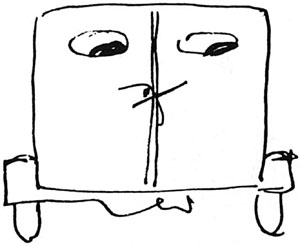

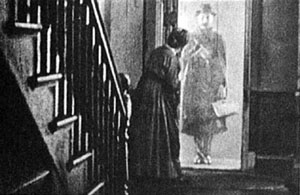
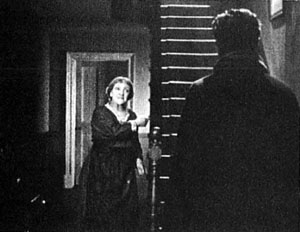

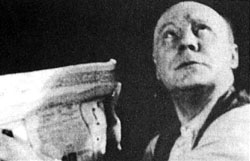
Now, we follow one girl home. There is her family and her boy friend, a detective from Scotland Yard, and they are kidding him: “Why aren’t you arresting Jack the Ripper?” They go on for a while, teasing and laughing. And then the atmosphere changes because the lights become dimmer. And Mother suddenly turns to her husband. “The gas is going down. Put a shilling in the meter, will you, please?” Now it is dark everywhere. Just then there is a knock at the door. Mother goes to open it. Here a quick crosscutting to the shilling being dropped into the meter. Back to Mother opening the door and then the lights go up. There is a man in a black cloak, pointing to the sign that says “Rooms to Let.”
So I didn’t bring the leading man on until fifteen minutes after the beginning of the film. They show him to his room. Now, Father falls off his chair with a loud crash. The new lodger is unnerved by the noise and this makes him appear suspicious to the others. In his room the man paces up and down. You must remember that we had no sound in those days, so I had a plate-glass floor made through which you could see the lodger moving back and forth, causing the chandelier in the room below to move with him. Naturally, many of these visual devices would be absolutely superfluous today because we would use sound effects instead. The sound of the steps and so on.
F.T. In any case, in your recent movies, there are far fewer special effects. Nowadays you use an effect only when it’s necessary to generate emotion, whereas in the past you seemed to put them in just for the fun of it. I don’t imagine you would show someone through a glass floor now.
A.H. That’s the change of style. Today I would simply use the swaying chandelier.
F.T. I mention this because some people claim that your movies contain a great many gratuitous effects. I believe, on the contrary, that your camerawork is becoming almost invisible. In many pictures the director attempts to provide the Hitchcock touch by placing the camera in an unlikely spot. I have in mind, for example, Lee Thompson, a British director. In one of his so-called Hitchcockian pictures the star goes to fetch something from the refrigerator, and oddly enough, the camera is located inside the refrigerator, in the rear. Would you have done it that way?
A.H. Certainly not. That’s like shooting through the fireplace, behind the flames.
F.T. The finale of The Lodger, when the hero is handcuffed, suggests a lynching.
A.H. Yes. When he tried to climb over the railings. Psychologically, of course, the idea of the handcuffs has deeper implications. Being tied to something . . . it’s somewhere in the area of fetishism, isn’t it?
F.T. I don’t know, but I have noticed that handcuffs have a way of recurring in your movies.
A.H. Well, look at the way the newspapers like to show people being taken to jail in handcuffs.
F.T. True. In fact, sometimes they even circle the handcuffs with a white line.
A.H. I remember one time when they showed the head of the New York Stock Exchange being jailed. He was handcuffed to a Negro. Later on I used that in The Thirty-nine Steps.
F.T. Yes, a man and woman linked to each other. Handcuffs are certainly the most concrete—the most immediate—symbol of the loss of freedom.
A.H. There’s also a sexual connotation, I think. When I visited the Vice Museum in Paris, I noticed there was considerable evidence of sexual aberrations through restraint. You should try to go there sometime. Of course they also have knives, the guillotine, and all sorts of information. Anyway, getting back to the handcuffs in The Lodger, I think the idea was inspired, to a certain extent, by a German book about a man who spends a whole day in handcuffs and tells about all the problems he runs into during that day.
F.T. Would that be From Nine to Nine by Leon Perutz? I believe Murnau was interested in doing a screen version of it around 1927.
A.H. It might be that one.
F.T. Is it farfetched to suggest that in the scene where the man in handcuffs is backed up against the railing, you were trying to evoke the figure of Christ?
A.H. When the people try to lift him and his arms are tied together? Naturally, that thought did occur to me.
F.T. All of this adds up to the fact that The Lodger was really the first Hitchcockian picture, primarily through the theme that recurs in almost all of your later works: a man accused of a crime of which he’s innocent.
A.H. That’s because the theme of the innocent man being accused, I feel, provides the audience with a greater sense of danger. It’s easier for them to identify with him than with a guilty man on the run. I always take the audience into account.
F.T. In other words, it’s a theme that satisfies the audience’s fascination with the clandestine, while also allowing it to identify with the character. Most of your works are about an ordinary man who is involved in an out-of-the-ordinary situation.
Wasn’t it in The Lodger that you made your first personal appearance on the screen?
A.H. That’s right. I was sitting in a newsroom.I
F.T. Did you do it as a gag? Was it superstition? Or was it simply that there weren’t enough extras?
A.H. It was strictly utilitarian; we had to fill the screen. Later on it became a superstition and eventually a gag. But by now it’s a rather troublesome gag, and I’m very careful to show up in the first five minutes so as to let the people look at the rest of the movie with no further distraction.
F.T. I understand The Lodger was a great hit.
A.H. It was first shown to the staff of the distribution company and the head of their publicity department. They saw the film and then made their report to the boss: “Impossible to show it. Too bad. The film is terrible.” Two days later the big boss came down to the studio to look at it. He arrived at two-thirty. Mrs. Hitchcock and I couldn’t bear to wait in the studio to know the results and we walked the streets of London for an hour and a half. Finally, we took a cab and went back. We were hoping our promenade would have a happy ending and that everyone in the studio would be beaming. What they said was: “The boss says it’s terrible.” And they put the film on the shelf, canceled the bookings that had been made on the basis of Novello’s reputation. A few months later they decided to take another look at the picture and to make some changes. I agreed to make about two. As soon as the picture was shown, it was acclaimed as the greatest British film made up to that date.
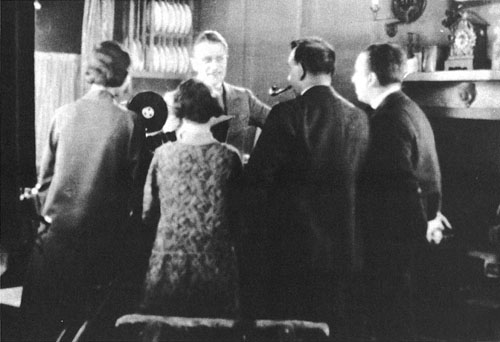
With his back to camera, at extreme right, Alfred Hitchcock during the shooting of The Lodger.
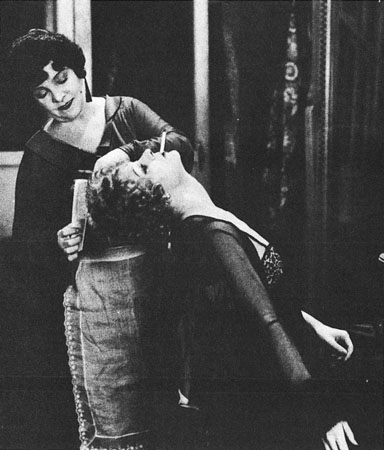
F.T. Do you remember what the distributors’ objections were?
A.H. I can’t remember. I suspect that the director who had had me fired as his assistant was still being “political” against me. I know he told someone, “I don’t know what he’s shooting. I can’t make head nor tail of it!”
F.T. Your next picture, Downhill, is about a boy who’s accused of a theft in his school. The school authorities expel him, and his father wants nothing more to do with him. As I remember it, he then has an affair with an actress and becomes a professional dancer in Paris. Then, we find him in Marseilles, where he thinks of shipping out to the colonies. Instead, he goes back to London, where his parents, who, in the meantime, have learned he was innocent all along, welcome him with open arms. The action is scattered in all kinds of different places; starting out in a British college, it moves on to Paris and then to Marseilles . . .
A.H. The original play was written that way.
F.T. That’s strange. Since it was a play, I would imagine that all the action would be set in the one location, in the college.
A.H. No, no, it was done as a series of sketches. It was a rather poor play. As it happens, the author was Ivor Novello.
F.T. As I remember it, the atmosphere of the school was very meticulously re-created.
A.H. Yes, but the dialogue was pretty dreadful in spots. And just like the transparent ceiling, there was another naïve touch that wouldn’t do today. That’s when the boy is thrown out of the house by his father. To show the beginning of his downhill journey, I put him on an escalator going down.
F.T. There was a very good scene in a Paris cabaret.
A.H. Yes, there I experimented a bit. I showed a woman seducing a younger man. She is a lady of a certain age, but quite elegant, and he finds her very attractive until daybreak. Then he opens the window and the sun comes in, lighting up the woman’s face. In that moment she looks dreadful. And through the open window we show people passing by earning a coffin.
F.T. There were also some dream sequences.
A.H. I had a chance to experiment in those scenes. At one point I wanted to show that the young man was having hallucinations. He boarded a tiny schooner, and there I had him go down to the fo’c’sle, where the crew slept. At the beginning of his nightmare he was in a dance hall. No dissolve, just straight cutting. He walked over to the side wall and climbed into a bunk. In those days dreams were always dissolves and they were always blurred. Though it was difficult, I tried to embody the dream in the reality, in solid, unblurred images.
F.T. As I recall it, that picture was not particularly successful. The next one was Easy Virtue, which I’ve never seen. According to my notes, it’s the story of a woman, Laurita, who becomes notorious when a young artist who is in love with her commits suicide and she divorces her husband, who is a drunkard. Later on she meets the scion of a respectable family, John, who marries her, knowing nothing of her past. But when his mother learns about Laurita’s former existence, she forces her son to divorce her. And the picture winds up with Laurita’s life in shambles.
A.H. That was taken from a Noel Coward play, and it contained the worst title I’ve ever written. I’m ashamed to tell you about it, but I will. At the beginning the film shows Laurita during her divorce case. She is very well known and she tells her story to the court. How she married a young man of good family and so forth. At any rate, her divorce is uncontested and is granted. And the word gets around that the famous Laurita is in the court. The photographers gather outside. Eventually she appears at the courthouse stairs, her arms out, and says, “Shoot, there’s nothing left to kill!”
An interesting scene in this picture is when John is proposing marriage to Laurita, and instead of giving him an immediate answer, she says, “I’ll call you from my house, around midnight.” Next, we show a little watch indicating it is midnight; it’s the wrist watch of a switchboard operator who is reading a book. A small light goes on on the board. She puts the plug in and is about to go back to her reading but automatically listens into the earphones. Then, she puts the book down, obviously fascinated by the phone conversation. In other words, I never show either of the two people. You follow what is happening by watching the switchboard operator.
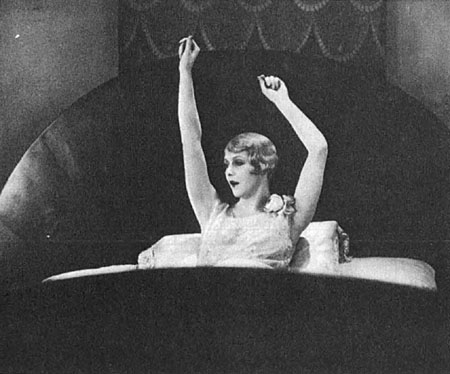
F.T. I’ve seen The Ring, which came right after that, several times. It isn’t a suspense film and has no crime ingredients. It’s a story about two prize fighters who are in love with the same woman. I like that picture very much.
A.H. Yes, that was really an interesting movie. You might say that after The Lodger, The Ring was the next Hitchcock picture. There were all kinds of innovations in it, and I remember that at the premiere an elaborate montage got a round of applause. It was the first time that had ever happened to me.
There were many things in that picture we wouldn’t do today. For instance, there was a little party one evening after a boxing match. The champagne is poured out and it is all bubbly. They drink a toast to the heroine and then discover she isn’t there; she’s out with another man. And so the champagne goes flat. In those days we were very keen on the little visual touches, sometimes so subtle that they weren’t even noticed by the public. You remember that the picture started on the fairgrounds. There was a fighter, played by Carl Brisson, and he was called One-Round Jack.
F.T. Because he knocked out his opponents in the first round?
A.H. That’s right. And in the crowd, watching the barker, there was an Australian, played by Ian Hunter. As the barker in front of the tent urged the crowd to go in, he had a little flap and could look back over his shoulder to see how the match was progressing. He used a sign to indicate the round number to the people standing outside. We showed volunteer fighters going into the tent and then coming out holding their jaw. Until Ian Hunter goes in. The seconds were sort of laughing at him and they didn’t even bother to hang up his coat. They just held it, thinking that he would never last more than one round. The match started and I showed the expressions of the seconds changing. Then we showed the barker looking in at the match. And at the end of the first round the barker took out the card indicating the round number, which was old and shabby, and they put up number two. It was brand-new! One-Round Jack was so good that they’d never got around to using it before! I think this touch was lost on the audience.